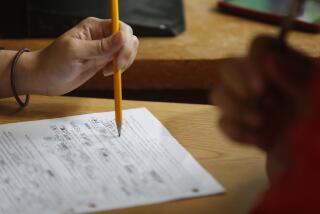Pushing past mediocrity in the classroom
Teacher wars are raging across the nation. One side blasts the “bad” teachers, waving around student test-score data and demanding accountability. On the other side are teachers: Defensive, closing the doors to their classrooms — and to the promise of improving their practice.
How do we halt the teacher-bashing, as President Obama urged in his State of the Union address, and still improve the quality of teaching? The answer is to radically change the evaluation conversation. A focus on watching teachers work — on how they actually interact with students — is long overdue.
Studies continue to highlight the lack of meaningful learning experiences forged through rich interactions between students and teachers. Only 7% of our nation’s children experience good teaching consistently in elementary school, according to a 2007 study led by Robert C. Pianta, dean of the school of education at the University of Virginia. Similar research in 2009 on fifth-grade classrooms showed that positive one-on-one interactions between a student and teacher were extremely rare. Mediocrity reigns.
Spurred by this reality, and the stubborn achievement gap between white and minority students, improving the effectiveness of teachers has become a mantra of education reform. But results from principals’ observations — known among teachers as “drive-bys” — are rightly dismissed as too “soft” and often inflated. Education reformers tell stories of Lake Wobegon evaluations: All teachers are above average but only a fraction of students are able to read and do math at grade level.
A recent study from the Bill & Melinda Gates Foundation spotlights a new approach. The study doesn’t shy from the controversial use of test-score data to evaluate teachers, but it also illuminates the power of better observation tools for measuring teachers’ actions. Using 360-degree videos and five standardized instruments for capturing the interactions of more than 1,300 teachers (in grades four through eight), researchers have documented a significant link between the elements of good teaching and students’ performance on math and reading tests. Some of these data-intensive tools are already becoming prevalent in preschools, where reliable test-score data don’t exist.
The tools work like this: A trained observer enters a classroom or clicks open a video and starts “coding” what he or she sees, systematically looking for signs that the teacher has provided helpful feedback to a student, artfully expanded on a difficult concept or exhibited any number of other interactions associated with good teaching. Teachers are scored numerically, and this method produces evaluations that are anything but soft. Data from one such observation tool, the Classroom Assessment Scoring System, which is part of the Gates research and is also used by Head Start, show just how poor some teaching can be. Educators, on average, score lower than 3 out of a possible 7 in “instructional support,” which measures their ability to provide meaningful feedback, extend conversations and encourage students to generate questions that propel learning.
Teachers may not like the idea of being watched. But we’ve talked to several who appreciate the assessments, as long as they get supportive feedback to take their teaching to a new level. “Observation is welcome,” said Jordan Henry, a high school English teacher in the Los Angeles Unified School District who has been a voice for change within the UTLA. Teachers yearn for more meaningful data on how they can improve, he said at a recent forum in Washington. “If we can fix that one piece, the rest is going to go down smoothly.”
Teachers also need a feedback loop that combines observation-based assessments with coaching, help with implementing new strategies, and then additional observation. This allows teachers, working with mentors and peers, to enhance their capacity to stimulate students’ learning. Recent studies using observation tools have shown that teachers improve when they have the benefit of coaches reviewing the videos and data from their classrooms. At a preschool in Virginia, where coaching and observational evaluation were begun recently, data quickly showed a positive impact on youngsters’ vocabulary, literacy and social skills — key indicators of school readiness. Studies on similar programs also linked coaching and observation to improvement on students’ end-of-year tests in high school.
Adding high-level observation tools to the evaluation process is expensive. But states and school districts are already shelling out thousands of dollars for other kinds of teacher training and evaluation systems, with scant evidence of improved outcomes — in the quality of instruction and, most important, for students.
It’s time to bring this new version of observation into the classroom and into the teacher-evaluation debate. Interactions between children and their teachers are at the heart of learning and the root of the best outcomes for students. To ensure real change, and the best possible teaching, we must examine those interactions.
Lisa Guernsey is the director of the Early Education Initiative at the New America Foundation in Washington. Susan Ochshorn is the founder of ECE PolicyWorks in New York. They are the authors of “Watching Teachers Work: Using Observation Tools to Promote Effective Teaching in the Early Years and Early Grades.”
More to Read
A cure for the common opinion
Get thought-provoking perspectives with our weekly newsletter.
You may occasionally receive promotional content from the Los Angeles Times.






